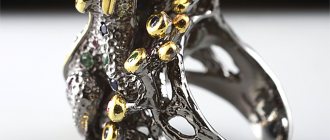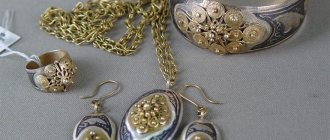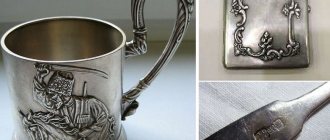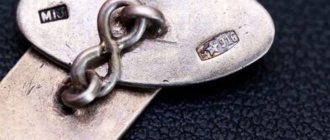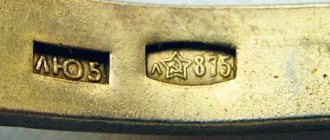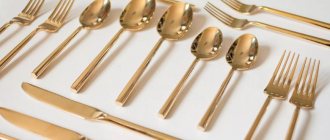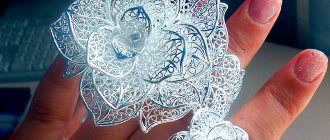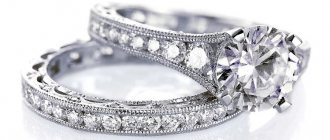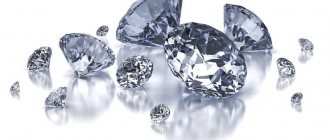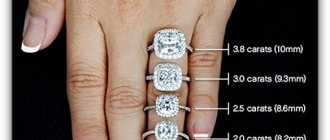General information
Sample 84, stamped on silver, served to determine the quality of white metal in Russia until 1927. The numbers indicated that the product contained 84 parts of pure silver and only 12 parts of other impurities.
In the past, almost a dozen samples were used to mark silver. Each product differed in the composition of the alloy, on which its cost depended. The lowest marking indicated that the metal consisted of only half of noble metal. Things were valued according to the principle that the purer the silver composition, the more you would have to pay for it. The stamp with the numbers 84 is now valued quite highly, but the final cost will depend on how old it was minted.
It is interesting that the pre-revolutionary “spool system” existed for another 10 years after the end of the monarchy era in 1917, because no better replacement has been invented to indicate the value of a product.
84 silver hallmark, used until 1908
Common antique samples
The spool system was in use from the beginning of assaying precious metals until 1927. The increase in silver content in the product and its cost depended on the sample. , the following symbols could be found on jewelry and cutlery
- 72 spools. The weight of silver is 0.750 of the total weight, which corresponds to modern 750 fineness. Until 1867, coins of 5, 10, 15 and 20 kopecks were minted from this alloy, but now it is used only in industrial production. 750 silver is used to make needles, springs and other products that operate under high loads.
- 84 spools. The specific gravity of the precious metal is 0.875 of the mass of the object. In the metric system this corresponds to 875. 84 sterling silver hallmarked by Tsarist Russia was used to make various household and household items (cup holders, spoons, boxes, cigarette cases, etc.), as well as jewelry - rings, earrings, chains. Products marked with this mark were most often found on the market, but only a few of them have survived to this day.
- 88 spools. The weight of silver is 0.916 of the weight of the alloy (metric 916 standard). In the USSR, 916 precious metal was actively used in the jewelry industry, but after some time it was replaced by a higher quality alloy - 925.
- 90 spools. The precious metal content is 0.937 of the total weight. In the metric system this corresponds to 937. Initially, jewelry and household items were made from such silver, but later the sample was considered unsuitable for production and was abolished.
- 91 spool. The specific gravity of silver is 0.947. At the moment, there is no sample corresponding to this value - it went out of use back in Soviet times.
- 96 spools. The weight of the noble metal is over 0.999, which corresponds to the modern value of 999. Silver of this standard contains virtually no impurities, but is almost never used for making jewelry due to its tendency to deform. In everyday life, it is used for the manufacture of parts for various devices and the production of solders.
Composition and properties of 84 sterling silver
It is not difficult to determine how much pure silver is in an alloy with a hallmark of 84. Taking into account the fact that the Russian pound contains 96 spools, you need to divide 84 by 96 and multiply by 100. Using simple mathematical operations, you get 87.5%. If we translate this result into a modern assay system, it turns out that 84 standard silver is analogous to the current 875 standard. Products with such markings were popular more than 100 years ago, but have not yet lost their relevance.
The 84-karat metal alloy contains 87.5% silver. The rest is copper. In addition, it may include:
- zinc;
- aluminum;
- nickel;
- cadmium.
Each of these additives determines the operational endurance of the product, its color and price.
Although pure silver is considered a more valuable material than its alloys, alloys give it strength. This allows us to produce various silver jewelry, interior and decorative items that will be distinguished not only by their beauty, but also by their strength. Such products are not subject to mechanical wear, do not wear out, do not scratch or darken. Copper also gives the alloy an interesting yellow tint.
Silver 84 or modern 875 is used mainly for decorative and artistic purposes. It can be worn, cleaned and washed without fear of fading, scratching or deformation.
84 sterling silver hallmark and mster's name
Spool and metric systems
At the beginning of the 18th century, Tsar Peter I created the first testing system in Russia - the spool test system. With its help, you can understand the percentage of noble metal and impurities (ligatures) in the alloy. Silver in its physical properties is a soft metal, and the alloy gives it hardness and strength. But there are also disadvantages: the more impurities in a product, the faster it darkens and the less shiny it is.
Silver glass 84 samples of Tsarist Russia
The spool testing system is based on the pre-revolutionary weight measure - the spool, which was equal to 1/96 of a pound. From this it follows that the 84th sample contains 84 parts of silver and 12 parts of copper. In the 20th century, the spool system was replaced by the metric system, which is based on the number of milligrams of silver per gram of alloy. This system was used until 1927.
In order to understand what 84 standard silver is equal to in the metric system, you need to divide 84 by 96 and multiply the resulting result by 1000. It follows from this that such an alloy is equal to 875 modern standard. Due to the fact that Russian standards have changed, not all ancient values coincide with modern samples. For example, the 82 spool standard in the metric system has a value of 854, which is not used today.
The use of royal silver 84 samples
84-carat silver was quite in demand in Tsarist Russia among wealthy citizens. Most often, household items, dishes, interior decorations and personal items were made from this alloy. For example, cigarette cases and boxes, glasses and cup holders, salt shakers and sugar bowls looked very impressive.
The cost of silver items was not too high, but middle class people could not afford to purchase them. Such things testified to the status of their owner. To increase prestige, some silver items were gilded in places. Silver boxes and snuff boxes with internal gilding looked especially impressive. The outside was silver and the inside shimmered beautifully with yellow.
Cup holder made of 84 sterling silver
Markings on silver spoons
Silver markings vary from manufacturer to manufacturer, but an hallmark is required. However, confusion may arise: for example, in the old days, the hallmark was set not only on silver, but also on silver-plated products.
And there are simply too many alloys similar to silver to count! If products made from them were produced in the Soviet Union or Russia, they will also be stamped (of course, without the coveted numbers):
- AL – aluminum;
- MELCH – cupronickel, an alloy of copper and nickel;
- MNC – nickel silver, copper and nickel plus zinc;
- MN – monel, cupronickel with a high nickel content;
- STAINLESS – “stainless steel”, that is, stainless steel.
Naturally, such cutlery is not silver and does not represent much value.
Advantages and disadvantages
Silver is a rather beautiful and shiny metal; you can “sculpt” various products from it, giving them any shape you like and creating unique patterns on the surface. Silverware can withstand repeated cleaning and washing without losing its appearance. With proper care, cutlery will not be scratched or tarnished.
The disadvantage of 84-carat royal silver is that it is not suitable for making jewelry due to its low quality for this area. Their cost will not recoup the costs invested in production. In addition, the presence of alloys in the alloy, in particular copper, gives the metal a yellowish tint, which is not always appropriate for jewelry.
Thimble made of 84 sterling silver
Antique value
Silver with the hallmark 84 has greater antique significance than current 875 items. You can recognize true values by the markings on products. Next to the numbers there is a stamp in the form of the profile of a woman in a kokoshnik. Her head is turned to the left on those items that were produced before the 20th century, and starting in 1908, the female profile began to look to the right. There should also be a mark of the master, or rather his initials, and the year of manufacture. All marking elements until the end of the 19th century were convex.
If you are lucky enough to own an 84-karat silver item, you can be sure that this is a truly unique product that has both cultural and historical value.
Cigarette case made of 84 sterling silver
What do the silver marks on spoons mean?
Silver is an inexpensive, but still noble metal. This means that it is subject to mandatory branding. For silver in Russia, a stamp in the shape of a lying barrel is accepted. In addition to the number indicating the content of precious metal, there is a female profile wearing a traditional Russian kokoshnik.
In addition to the mandatory hallmark, other marks may be affixed to the metal. Usually these are logos of manufacturers, brands, brands.
It is extremely difficult to understand all this diversity, and even more so if we are talking about antiques. The best option in this case is to submit the product for professional examination. The expert will indicate not only the precious metal content, weight and origin of the product, but also its estimated value.
You can, of course, experiment with homemade methods of determining the precious metal (iodine, lapis pencil, sulfur ointment and others like them), but no one can guarantee an accurate result. And there is also the risk of spoiling a valuable item: what if you received a spoon made at the Savva Morozov manufactory especially for the royal family?
Silverware produced in other countries bears the mark accepted in the country of origin. And in the Soviet Union, products made from precious metals were, as expected, decorated with a five-pointed star with a coat of arms in the center.
Price
The price of silver, like other precious metals, changes quite often. Although it is worth noting that compared to gold or platinum, this is the most stable alloy. Over a couple of years, the price per gram of metal changed by an average of five rubles and ranged from 25 to 30.5 rubles.
You can find out the current cost for a specific day in the reports of the Central Bank of Russia. Prices at pawn shops or antique markets may vary. But all this applies to silver in general, because... The 84-karat alloy is valued based on the antique value of the item.
The decline of pre-revolutionary jewelry art
The February events of 1917 forced many aristocrats to emigrate, which led to the closure of some workshops. The October Revolution finally destroyed wealthy customers, and robberies forced the vast majority of jewelers to flee to Europe. In 1918, searches began in large and small workshops; revolutionary sailors took away everything that looked like gold, silver and precious stones.
A huge amount of jewelry was sold abroad, and the proceeds went to fuel the world revolution. The commission created by the Bolshevik government did not understand the artistic value of silver items from the 19th century. The masterpieces of Sazikov, Faberge, Ovchinnikov and Khlebnikov were not melted down only for the reason that it was unprofitable.
Many items with museum value from private collections were presented to the Red Guards as rewards for military services. In the 1920s, a store opened in Leningrad where they sold palace property as old trash in an attempt to get at least some money for it. As a result, from Faberge’s heritage, which numbered about one hundred thousand items, no more than six hundred items remained in their homeland.
Russian silver is highly valued on the world antiques market. At the end of 2021, Fabergé's clockwork silver rhinoceros was sold at a London auction for £705,000. At Very Important Lot you will find antique vases, cutlery, serving pieces and trinkets that will enhance any collection.
Features of product care
If there are silver objects in the house with an indication of 84 standard, you should be able to properly care for them. After use, dishes and cutlery are washed with warm soapy water, then rinsed thoroughly and dried. Store products in a dry place, wrapped in soft cloth.
With prolonged contact with human skin, silver tends to oxidize and darken. This applies mainly to cigarette cases and various boxes, because... Jewelry of this type is rare. A similar reaction occurs due to the interaction of the metal with sweat. Previously, it was believed that this was a sign of poor health of a person or damage sent to him, but the darkening is purely chemical in nature.
If the silver item has darkened, clean it with a mixture of soda and salt. If the plaque is strong enough, then make a paste of soda, ammonia and toothpaste. Apply the composition to the surface to be cleaned with a brush and wait a couple of minutes. When the coating is gone, rinse the item with running water and wipe dry. If the stains do not go away on their own, you need to rub them a little with a cotton pad.
Any 84 sterling silver item will be an excellent gift or investment, and will be passed down in the family from generation to generation.
Catalog of Russian silver samples, hallmarks
We have tried to collect complete information about samples of Russian silver products from the 18th and 19th centuries, by which we can determine the master, the year of production and the city of the sample.
Form for selling antiques
- Antique silver samples of Veliky Ustyug
- Antique silver samples from Vologda;
- Antique silver hallmarks of Nizhny Novgorod;
- Antique silver samples of Kazan;
Antique silver from St. Petersburg, hallmarks
- Hallmarks of Russian silver by Carl Faberge. silver samples;
- Antique silver silver from the Russian jewelry house of the Grachevs Mikhail and Simeon Gavrilovich, hallmarks;
- Russian jewelry master Pavel Fedorovich Sazikov, silver samples;
- Jewelry workshop of Russian silver, master's sample Karl Bolin;
Antique silver from Moscow factories, hallmarks
- Moscow factory of silver products of Ivan Semyonovich Gubkin, hallmarks;
- Russian silver factory of Nikolai Vasilyevich Nemirov-Kolodkin, silver hallmarks;
- Jewelry master of silver products Ovchinnikov Pavel Akimovich, silver samples;
- Masterpieces of silversmith Ivan Petrovich Khlebnikov, hallmark silver;

